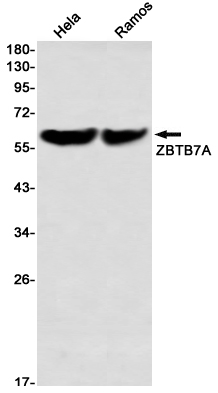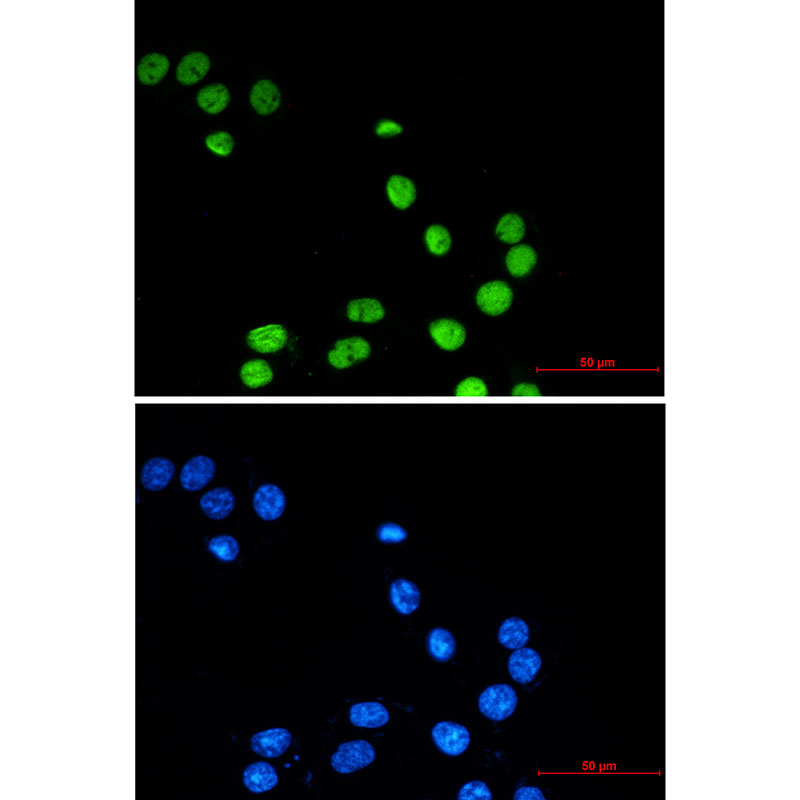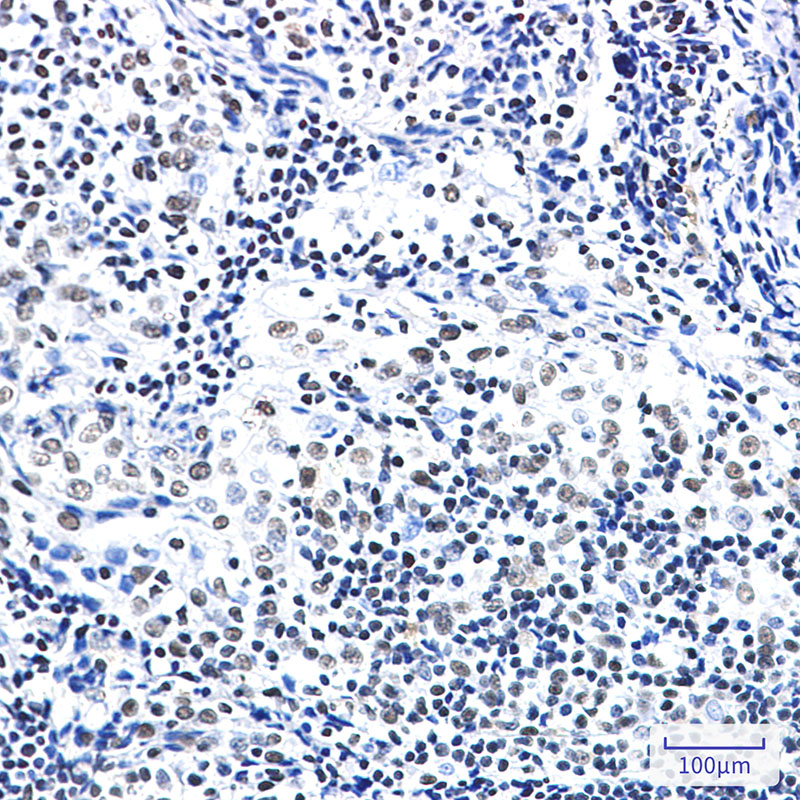


| WB | 1/500-1/1000 | Human,Mouse,Rat |
| IF | 1/20 | Human,Mouse,Rat |
| IHC | 1/50-1/100 | Human,Mouse,Rat |
| ICC | 1/50-1/200 | Human,Mouse,Rat |
| FCM | 咨询技术 | Human,Mouse,Rat |
| Elisa | 咨询技术 | Human,Mouse,Rat |
| Aliases | FBI1; LRF; Pokemon; TIP21; ZBTB7; ZBTB7A; ZNF857A |
| Entrez GeneID | 51341 |
| WB Predicted band size | Calculated MW: 61 kDa; Observed MW: 61 kDa |
| Host/Isotype | Rabbit IgG |
| Antibody Type | Primary antibody |
| Storage | Store at 4°C short term. Aliquot and store at -20°C long term. Avoid freeze/thaw cycles. |
| Species Reactivity | Human |
| Immunogen | A synthetic peptide of human ZBTB7A |
| Formulation | Purified antibody in TBS with 0.05% sodium azide,0.05%BSA and 50% glycerol. |
+ +
以下是3篇与ZBTB7A抗体相关的参考文献及其摘要概括:
---
1. **文献名称**:*ZBTB7A governs oncogenic metabolic reprogramming in hepatocellular carcinoma*
**作者**:Wang, H., et al.
**摘要**:该研究通过免疫组化(IHC)和Western blot分析ZBTB7A在肝癌组织中的表达,发现其低表达与糖酵解增强和患者预后不良相关。研究使用特异性ZBTB7A抗体验证了其在代谢重编程中的抑癌作用。
---
2. **文献名称**:*ZBTB7A suppresses AML progression through repression of glycolysis and proliferation*
**作者**:Hosokawa, H., et al.
**摘要**:文章利用ZBTB7A抗体进行染色质免疫沉淀(ChIP)和流式细胞术,证明ZBTB7A通过抑制MYC介导的糖酵解基因(如GLUT1和PKM2)调控急性髓系白血病(AML)的细胞增殖和分化。
---
3. **文献名称**:*The role of ZBTB7A in metabolic reprogramming and immune evasion in cancer*
**作者**:Liu, X., et al.
**摘要**:研究通过Western blot和免疫荧光技术,结合ZBTB7A抗体,揭示了该蛋白在肿瘤微环境中协调代谢通路(如HIF-1α信号)与免疫抑制功能的作用机制。
---
以上文献均通过ZBTB7A抗体在实验方法中验证了该蛋白的表达、定位或功能,涉及癌症代谢、免疫调控及临床预后分析。
ZBTB7A, also known as Pokemon or LRF, is a member of the POK (POZ and Krüppel) zinc finger transcription factor family. It contains an N-terminal BTB/POZ domain for protein interactions and C-terminal zinc finger motifs for DNA binding. Initially identified as a proto-oncogene, ZBTB7A regulates critical cellular processes, including cell cycle progression, differentiation, and metabolism. It functions as a transcriptional repressor, targeting genes involved in glycolysis (e.g., GLUT1. PFKP) and tumor suppression (e.g., p53. ARF). Its dual role in cancer remains debated, acting as either an oncogene or tumor suppressor depending on cellular context and cancer type. For example, it promotes lymphomagenesis but suppresses metastasis in melanoma.
ZBTB7A antibodies are essential tools for studying its expression, localization, and molecular interactions. These antibodies enable detection via techniques like Western blotting, immunohistochemistry, and chromatin immunoprecipitation (ChIP). Commercial ZBTB7A antibodies are typically raised against specific epitopes, such as the N-terminal or C-terminal regions, with validation in knockout models to ensure specificity. Researchers use these antibodies to explore ZBTB7A's involvement in cancer progression, immune regulation, and metabolic reprogramming. However, inconsistent findings across studies highlight the need for rigorous antibody validation and context-dependent interpretation. Recent work also links ZBTB7A to therapeutic resistance, making it a potential biomarker or target in precision oncology.
×